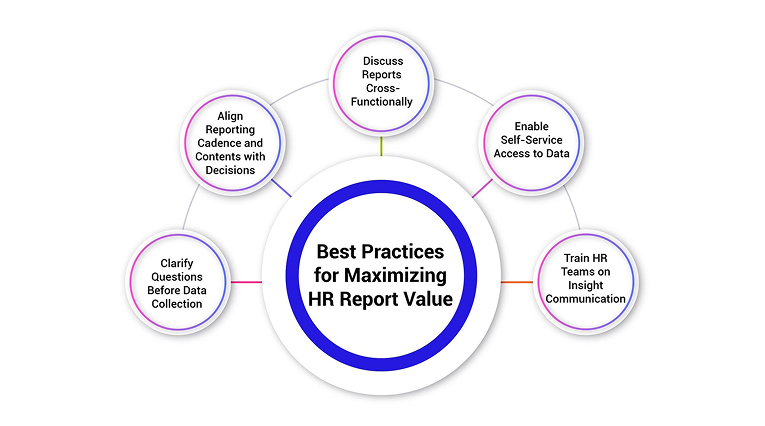
In today’s fast-paced business world, success depends on making data-driven decisions—especially when it comes to managing your workforce. That’s where HR reports come in.
From recruitment and retention to compensation and compliance, HR reports transform raw data into clear, actionable insights that empower leaders to align people strategies with business goals.
In this guide, we’ll explore 12 essential HR reports every organization needs—and how each one helps you make smarter, faster, and more strategic decisions.
Effective workforce planning ensures your workforce aligns to current and future organizational needs. HR reports enable you to forecast talent needs, optimize hiring and prepare for growth. Four workforce planning reports form the foundation:

The headcount report provides a real-time overview of the total number of employees across different locations, departments, and roles in the organization. Tracking headcount trends over time enables leaders to accurately forecast future talent needs, plan hiring budgets, and prepare for growth.
For example, a dip in overall headcount could indicate higher than expected attrition requiring further investigation. Similarly, a particular department showing a rapid increase in headcount may warrant evaluating if skill gaps exist internally before recruiting additional talent. Having full visibility into granular headcount data and trends empowers strategic workforce planning.
Understanding the reasons behind employee turnover is crucial for developing targeted retention strategies. The turnover report breaks down employee termination reasons, at-risk segments of the workforce, the cost impact of attrition, and turnover trends over time.
Leaders can analyze this report to identify problem areas driving increased turnover, such as ineffective managers, lack of career development, or compensation issues. Equipped with these insights, HR can implement focused initiatives to improve engagement and retention, such as manager coaching, internal mobility programs, or pay benchmarking. A detailed turnover analysis shines a light on enhancing employee experience.
By tracking key talent acquisition metrics, organizations can optimize hiring productivity and efficiency. Essential recruitment metrics to include in this report are time-to-fill open roles, cost-per-hire, candidate pipeline health, and source of hire.
Monitoring recruitment KPIs enables leaders to set targets for process improvements, boost recruiter productivity, reduce costs, and attract top talent. For instance, an increasing time-to-fill could warrant investments in recruitment technologies like an applicant tracking system. This data is invaluable for strategic hiring decisions.
A robust succession planning program is vital for ensuring smooth leadership transitions and continuity. The succession planning report provides an overview of high-potential employees at different management levels across various departments.
Leaders can develop tailored development plans for successors to address skill or experience gaps well in time and create succession slates of backups for critical roles. Detailed visibility into the talent pipeline for key roles provides reassurance that the organization is prepared for planned and unplanned transitions.
Beyond workforce planning, HR reports also unlock ways to optimize employee productivity, performance and experience. These reports reveal how to motivate talent and promote professional growth.
Taking a metrics-driven approach to learning and development initiatives helps drive optimal training outcomes. This report consolidates data on training completion rates, program costs, employee feedback, and progress tracked against targeted performance goals.
Leaders can leverage these insights to right-size L&D budgets, address low completion rates, gather feedback to improve content relevancy, and demonstrate alignment with performance objectives. An informed lens into the performance of L&D programs enables continuous enhancement.
An accurate picture of employee performance levels across the organization enables targeted interventions to enhance productivity. This report compiles key metrics including employee ratings, areas of praise and needs improvement, and comparisons across peer groups or teams.
Leaders can use the report’s insights to refine performance management cycles, define employee skill-building priorities in collaboration with managers, identify high performers for fast-tracked career growth, and spotlight teams executing well as role models.
Understanding sentiment across the workforce is invaluable for retaining top talent by fostering a high-performance work culture. This report summarizes employee engagement levels, participation rates in engagement surveys, and recurring themes across qualitative feedback on culture, work practices, policies etc.
Leaders can diagnose problem areas reported through surveys, such as communication gaps, lack of collaboration, or burnout drivers. Equipped with data-backed insights into the employee experience, leaders can develop targeted people priorities around culture, enablement, and growth to boost retention.
As the competition for skilled talent intensifies, it is crucial for compensation and benefits offerings to remain competitive leveraging market benchmarking. This report compares internal compensation ratios across job levels to industry standards among key talent competitors.
Leaders can utilize this analysis to recalibrate out-of-line salary ranges, inform merit increase budgets, optimize incentive structures, and enhance benefits packages. Having an accurate read of compensation metrics empowers data-driven decisions to attract and retain top performers.
In addition to elevating your workforce, HR reports fuel bigger picture strategies around growth, compliance and resource allocation. These four reports connect the dots between HR initiatives and broader business goals:
A proactive approach to employee health and safety has a multiplier effect on productivity, absenteeism, costs, and continuity of operations. This report tracks occupational injury rates, prevention programs completions, sources of workplace hazards, and mitigation measures.
Leaders can use insights from this report to implement control measures for identified hazards, demonstrate ROI on workplace safety programs, and showcase how HR initiatives safeguard employee wellbeing and ensure business continuity.
Diverse teams drive higher business results through enhanced innovation, decision quality, and performance. This report audits the diversity makeup across different levels of the organization mapped to talent availability, sheds light on equity through granular demographic representation and pay gap analyses, while also tracking inclusion index scores.
Leaders can define strategic priorities and measurable goals around nurturing under-represented talent, broadening sourcing approaches, removing unconscious bias in people processes, and cultivating an inclusive culture.
An outside-in perspective of HR metrics in comparison to industry benchmarks enables an objective assessment of operational efficiency. This report showcases key performance indicators related to HR spend, programs, and headcount ratios against benchmarks.
Leaders can gauge process efficiency, technology maturity, and resource allocation to determine whether to optimize investments and staffing by reallocating budgets to fill capability gaps that exist relative to HR best practices.
Bringing key workforce metrics together in an interactive data dashboard empowers business leaders to filter and visualize employee data most relevant to informing their decisions, covering the spectrum from big picture indicators like turnover to granular details like employee addresses.
Democratizing access to HR analytics across the organization enables data-driven dialogue and planning around recruiting, development, retention and broader people strategies aligned to overarching business objectives.
Simply creating HR reports checks a box, but genuinely embedding insights into decisions takes some finesse. Follow these best practices to maximize value:

The first step to extract greater value from HR reports is to clarify the specific questions each report should answer even before starting data collection. Some examples of key questions include:
Defining the purpose and questions upfront provides focus for report development to ensure relevant data is gathered to provide meaningful insights. It also helps streamline data analytics efforts instead of just extracting all available data.
Another key success factor is aligning the timing and contents of HR reports with key business decisions they intend to inform.
For instance, have quarterly recruiting metrics reports in place ahead of leadership strategy meetings regarding hiring budgets or goals for the upcoming year. Ensure these reports highlight recruiting KPIs the leaders will need to make more data-driven workforce decisions.
Likewise, if an annual compensation review process is underway, provide corresponding reports on employee performance ratings and attrition risks for various departments beforehand.
This synchronization between HR reporting outputs and business decision inputs helps leaders easily apply essential workforce insights.
HR reports should spark constructive discussion across functions, not just be circulated as an FYI.
Schedule working sessions where HR presents recent reports and trends to business unit leads. Have an open dialogue about the implications—both risks and opportunities—of reporting findings across operations.
This facilitates a cross-functional perspective, instead of HR analytics happening in a silo. It can uncover more creative solutions as teams connect HR data points with business priorities.
Providing interactive self-service analytics tools allows managers to access and filter HR data on their own too. They can customize views specific to their team’s needs instead of solely relying on static HR reports.
User-friendly data dashboards with visualizations make it easier for leaders across the organization to act on essential people insights. They can draw connections to various operational metrics relevant to their focus areas.
It’s equally important to train HR staff itself on translating analytics into compelling data stories and actionable recommendations. They should master both data analysis techniques as well as executive-level communication abilities.
Guide them how to spotlight key takeaways, make data relatable with case examples, discuss future outlooks, and offer specific improvement strategies tailored to stakeholder priorities.
This capacity to convey analytics effectively helps position HR as a strategic business partner.
With the right HR reports fueling your business decisions, you gain an intricate understanding of your workforce along with the agility to respond to changing needs. Now equip yourself with analytics translating employee metrics into bottom line value. The result? Improved talent acquisition, superior employee experience and data-driven workforce strategies that accelerate business success.